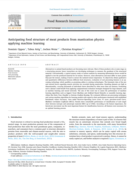New publication in Food Research International [30.10.23]
Tabea Attig and Christian Krupitzer from the Department of Food Informatics are Co-Authors of the publication "Anticipating food structure of meat products from mastication physics applying machine learning" in Food Research International (Impact Factor: 8.1 (2023)).The publication "Anticipating food structure of meat products from mastication physics applying machine learning" by Dominic Oppen (Department of Food Material Science, Institute of Food Science and Biotechnology, University of Hohenheim, Stuttgart, Germany) with the co-authors, Tabea Attig (Department of Food Informatics, Institute of Food Science and Biotechnology, and Computational Science Hub, University of Hohenheim, Stuttgart, Germany), Jochen Weiss (Department of Food Material Science, Institute of Food Science and Biotechnology, University of Hohenheim, Stuttgart, Germany), Christian Krupitzer (Department of Food Informatics, Institute of Food Science and Biotechnology, and Computational Science Hub, University of Hohenheim, Stuttgart, Germany) was published in Food Research International, Elsevier (Impact Factor: 8.1 (2023)).
Alternatives to animal-based products are becoming more relevant. Most of those products rely at some stage on a structuring process; hence researchers are developing techniques to measure the goodness of the structured material. Conventionally, a typical sensory study or texture analysis by measuring deformation forces would be applied to test the produced material for its texture. However, meat alternatives and meat differ in more points than just the texture, making it hard to extract the isolated texture impression. To objectively obtain qualitative and quantitative differences between different food structures, evaluation of oral processing features is an up coming technology which qualifies as promising addon to existing technologies. The kinematic data of the jaw and exerted forces regarding muscle activities are recorded during mastication. Resulting datasets are high in dimensionality, covering thousands of individual chews described by often more than ten features. Evaluating such a dataset could benefit from applying computational evaluation strategies designed for large datasets, such as machine learning and neural networks. The aim of this work was to assess the performance of machine learning algorithms such as Support Vector Machines and Artificial Neural Networks or ensemble learning algorithms like Extra Trees Classifier or Extreme Gradient Boosting. We evaluated different pre-processing techniques and various machine algorithms for learning models with regard to their performance measured with established benchmark values (Accuracy, Area under Receiver-Operating Curve score, F1 score, precision-recall Curve, Matthews Correlation Coefficient (MCC)). Results show remarkable performance of classification of each single chew between isotropic and anisotropic material (MCC up to 0.966). According to the feature importance, the lateral jaw movement was the most important feature for classification; however, all features were necessary for an optimal learning process.
The publication is available at: linkinghub.elsevier.com/retrieve/pii/S0963996923011249


